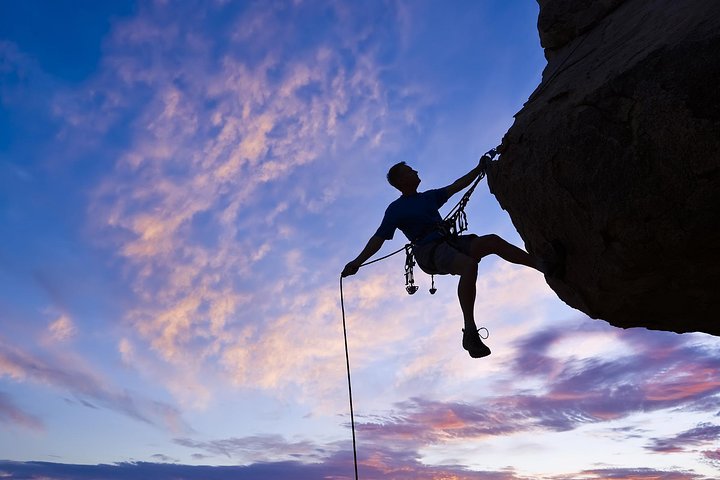Belay Better: Taking Your Outdoor Climbing Skills Beyond the Gym in San José
Sharpen your belay skills and learn real-rock ropecraft in the Central Valley of Costa Rica
The limestone and volcanic rock near San José take on a voice of their own as you step out of the city heat and into scrubby foothills—the cliffs humming with wind, the canopy below rustling like a crowd waiting its turn. On a Level 2 outdoor rock-climbing clinic you trade the gym’s predictable walls for a living, breathing rock face that rewards patience and precise technique. The day begins with a brisk review: harnesses snug, figure-eight knots checked, shoes tied. Then the instructor points to the crag and says the two words everyone wants to hear: belay school.
Trail Wisdom
Bring your own shoes and harness
Personal fit matters for both comfort and performance—rentals are fine, but your own gear reduces distractions.
Hydrate and time your session
Morning sessions avoid heat and afternoon showers—drink plenty of water before and during the clinic.
Practice calls aloud
Verbal communication is the backbone of safe belaying—say it clearly and confirm out loud.
Expect dusty approaches
Wear grippy shoes for the trail and watch for loose rock near the base of cliffs.
Local Knowledge
Hidden Gems
- •Approach paths often pass small family-run coffee farms—ask your guide for a quick stop and taste.
- •Barrio Escalante in San José is a great spot for post-climb craft beer and local cuisine.
Wildlife
Tropical hummingbirds, Howler monkeys (in higher foothills)
Conservation Note
Climbers are encouraged to follow Leave No Trace practices, avoid creating new fixed anchors, and respect private farmland on approaches.
The Central Valley’s cliffs are the product of volcanic uplift and erosion; human movement here shifted from indigenous trails to colonial roads and now to recreational routes.
Seasonal Guide
spring
Best for: Transition weather, Lower afternoon showers, Fewer tourists
Challenges: Variable rain patterns, Occasional muddy approaches
Spring (Mar–May) starts to shift toward the rainy season; mornings are often clear but afternoons can cloud up—plan earlier starts.
summer
Best for: Lush landscapes, Active wildlife, Long daylight hours
Challenges: Regular afternoon downpours, Humidity
Summer (Jun–Aug) brings consistent green season rains—expect local showers and adjust timing for dry windows.
fall
Best for: Warm temperatures, Fewer crowds, Vibrant countryside
Challenges: Wettest months in some years, Slippery approaches
Fall (Sep–Nov) can be the wettest period; courses run but carries more rain-related logistics—check forecasts.
winter
Best for: Drier conditions, Stable weather, Clear views
Challenges: Higher daytime heat in lowlands, Busy travel season
Winter (Dec–Feb) is the Central Valley dry season—ideal for consistent climbing weather and clear lines.
Photographer's Notes
What to Bring
Climbing shoesEssential
Better edging and sensitivity on real rock than rental shoes.
HarnessEssential
A comfortable, well-fitted harness makes belaying and lowering safer and more comfortable.
Belay device (ATC or similar)
Instructors may provide devices, but having your own helps practice consistency.
Light wind/rain shell
Quick protection against tropical showers on approaches and belay ledges.
Common Questions
Do I need prior outdoor climbing experience?
You should already know how to tie a figure-eight knot, use a harness, and climb top-rope in a gym; the clinic builds on those basics to teach outdoor belaying skills.
Is gear provided?
Many operators provide shared ropes, helmets, and some belay devices—bring your own shoes and harness if possible for the best fit.
What is the minimum age?
Age minimums vary by operator—confirm at booking, but participants are typically teens and adults with basic climbing experience.
How do I get to the crag from San José?
Most climbs are a 30–90 minute drive from central San José; many tours include transport or can advise on local taxi options.
Will I learn to lead climb?
This Level 2 course focuses on belay techniques and rope management for top-rope and lowering; lead-climbing and multi-pitch lead skills are usually taught in advanced courses.
What happens in wet weather?
If the rock is unsafe due to rain, operators will typically reschedule or move to a more sheltered area—confirm cancellation policies when booking.
What to Pack
Climbing shoes (fit and performance), harness (safety and comfort), water (hydration in heat), sunscreen (UV protection)
Did You Know
San José sits in Costa Rica’s Central Valley at roughly 1,172 meters (about 3,845 ft) above sea level—a factor that affects temperature and stamina during climbs.
Quick Travel Tips
Fly into SJO (Juan Santamaría), Book morning sessions to avoid afternoon rain, Carry cash for roadside sodas, Confirm gear provided ahead of time
Local Flavor
After a day on the rock, head to Mercado Central for traditional casado plates or Barrio Escalante for craft breweries and modern Costa Rican cuisine; small corner 'sodas' serve hearty, inexpensive meals and strong coffee. Connect with local climbing groups to hear beta and support community stewardship.
Logistics Snapshot
Closest airport / trailhead: Juan Santamaría International Airport (SJO) / various Central Valley crags; Driving distance from San José: 30–90 minutes depending on site; Cell service expectations: generally good near city crags, patchy at remote spots; Permits or passes required: typically none for day clinics—confirm with operator.
Sustainability Note
Many climbing areas border private farms and sensitive habitats—pack out all trash, avoid adding bolts, and support local guides who practice low-impact access.
